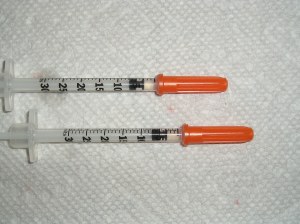Many of you are already aware that my cat, Little Man, the subject of my book, Mighty Little Man: My Story, His Story, Our Story, is a diabetic. He has been a diabetic for over ten years, and I have given him insulin injections twice a day for all that time. In his younger days, when he was at his heaviest weight, Little Man received as much as eleven units of insulin twice a day. Within the past year however, as he has aged and is no longer quite so heavy, his insulin requirements have decreased significantly. It was within this same timeframe that I began to notice fluctuations in Little Man’s blood glucose readings, which I measure myself with the use of my own at-home glucometer.
For the longest time, these fluctuations were simply unexplained, and I was forced to test Little Man’s blood glucose almost as often as prior to every dose. What was so alarming was when his blood glucose dropped below the normal range, seemingly with no explanation. As a result, I decreased his insulin dose to compensate only to see his blood glucose skyrocket shortly thereafter. It was a very frustrating time. But now I believe I have discovered the cause, and it has nothing to do with his medical condition.
It’s because of the syringes, and I do not believe it is a problem unique to any single manufacturer. Most likely, it is a problem with several, if not all, of them.
In the picture below are two syringes, each loaded with a “dose” of 3.0 units of water, which, like insulin, is a clear, colorless liquid. There is a problem with one of them. Can you tell which one?
If you can’t see the problem, you are not alone. After all, I’ve been using these syringes for over ten years and I didn’t notice it either until very recently.
What if we add some color to the liquid in the syringes? Does that help? Look closely at the picture below.
Still don’t see it? How about if we place the syringes close together, like this:
Now do you see it? That’s right! In the first two pictures above, the syringe on the bottom is the bad one, and in the picture with the syringes placed closer together, the bad one is the one on the right. That’s because it contains TOO MUCH liquid, to the tune of about half a unit, even though it “reads” the same as the other, correct syringe.
How did this happen? Look at the next picture below. Both syringes are empty with their plungers pushed all the way to the top of the barrel.
In the syringe on the left, the correct one, the “zero” line aligns perfectly with the top of the plunger. But in the one on the right, the “bad” syringe, the zero line is marked significantly lower than the true zero. See how much of the plunger is above the zero line? Wow.
It may not look like much, but let’s put this into proper perspective. As seen in the above picture, using the bad syringe on the right would result in a dose approximately 0.5 units higher than intended. For example, an intended dose of 2.5 units would actually be 3.0 units if the plunger is drawn to the pre-printed mark indicating 2.5 units—an overdose of 20%! If doses are given twice a day, there is the potential for an OVERDOSE of TWO FULL DOSES of insulin in a matter of ONLY FIVE DAYS!!
I think that may explain the “unexplained” fluctuations in Little Man’s blood glucose readings. Ever since I discovered this problem, I adjust the way I use the syringes when I give Little Man his injections—and I have seen no fluctuations since.
The bottom line? Check the ”zero” before EVERY dose, and draw the syringe accordingly.
DISCLAIMER: I am not a physician or veterinarian and have no medical training beyond what I have learned in various veterinarians’ offices toward the care of my dogs and cats. However, I am an engineer and very familiar with measurement and testing methods and believe this issue to be of extreme importance to diabetics patients and their caretakers.




